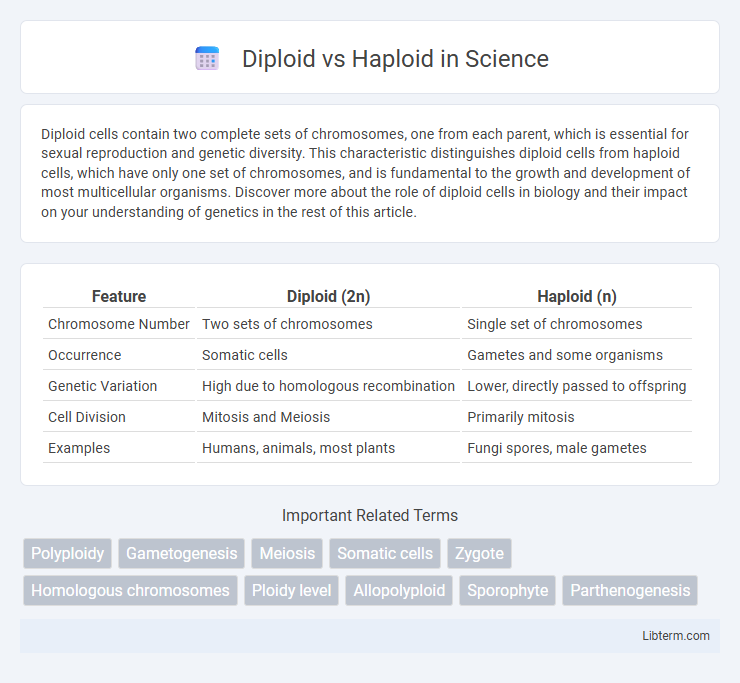Diploid cells contain two complete sets of chromosomes, one from each parent, which is essential for sexual reproduction and genetic diversity. This characteristic distinguishes diploid cells from haploid cells, which have only one set of chromosomes, and is fundamental to the growth and development of most multicellular organisms. Discover more about the role of diploid cells in biology and their impact on your understanding of genetics in the rest of this article.
Table of Comparison
| Feature | Diploid (2n) | Haploid (n) |
|---|---|---|
| Chromosome Number | Two sets of chromosomes | Single set of chromosomes |
| Occurrence | Somatic cells | Gametes and some organisms |
| Genetic Variation | High due to homologous recombination | Lower, directly passed to offspring |
| Cell Division | Mitosis and Meiosis | Primarily mitosis |
| Examples | Humans, animals, most plants | Fungi spores, male gametes |
Introduction to Ploidy: Diploid and Haploid Defined
Ploidy refers to the number of sets of chromosomes in a cell, with diploid cells containing two complete sets, one from each parent, which is characteristic of most somatic cells in animals and plants. Haploid cells carry a single set of chromosomes, typical of gametes like sperm and egg cells, enabling sexual reproduction through the fusion of two haploid cells to restore diploidy. Understanding diploid and haploid states is fundamental in genetics, cell biology, and reproduction, impacting genetic diversity and stability.
Cellular Basis: What Makes a Cell Diploid or Haploid?
A diploid cell contains two complete sets of chromosomes, one set inherited from each parent, totaling 46 chromosomes in humans, which allows for genetic diversity and proper cellular function. A haploid cell carries only one set of chromosomes, typically 23 in humans, as seen in gametes like sperm and egg cells, enabling sexual reproduction. The cellular distinction arises during meiosis, where diploid cells undergo division to produce haploid gametes, ensuring chromosome number stability across generations.
Chromosome Numbers: Diploid vs. Haploid Explained
Diploid cells contain two complete sets of chromosomes, one inherited from each parent, resulting in a total of 46 chromosomes in humans, whereas haploid cells have only one set of chromosomes, totaling 23 in humans, essential for sexual reproduction. The diploid chromosome number (2n) allows for genetic diversity and stability during mitosis, while the haploid chromosome number (n) is crucial during meiosis for forming gametes, ensuring chromosome number consistency across generations. Understanding the difference in chromosome numbers between diploid and haploid cells is fundamental in genetics, cell biology, and reproduction studies.
Role in Sexual Reproduction: Comparing Functions
Diploid cells contain two sets of chromosomes, enabling the fusion of male and female gametes during sexual reproduction to restore chromosome number and ensure genetic diversity. Haploid cells, with a single chromosome set, function as gametes--sperm and eggs--carrying genetic information from each parent to offspring. The interplay between diploid and haploid stages is crucial for maintaining species stability and promoting variation through meiosis and fertilization processes.
Diploid and Haploid in Human Life Cycle
Human life cycle alternates between diploid and haploid stages, with diploid cells containing 46 chromosomes formed through fertilization, representing the organism's somatic cells. Haploid cells, such as sperm and egg, contain 23 chromosomes and are produced by meiosis to ensure genetic diversity during sexual reproduction. The transition from haploid to diploid occurs when two gametes fuse, restoring the diploid chromosome number essential for normal human development.
Gametes vs. Somatic Cells: Key Distinctions
Diploid cells contain two complete sets of chromosomes, one from each parent, making them characteristic of somatic cells responsible for body functions and growth. Haploid cells, primarily gametes such as sperm and egg cells, possess a single set of chromosomes essential for sexual reproduction and genetic diversity. The key distinction lies in chromosome number and function: somatic cells maintain diploidy for stability, while gametes are haploid to enable chromosome number restoration during fertilization.
Importance in Genetic Variation
Diploid cells contain two sets of chromosomes, allowing for the combination of genetic material from both parents, which significantly enhances genetic variation during sexual reproduction through processes like meiosis and recombination. Haploid cells, having only one chromosome set, play a crucial role in maintaining genetic diversity by ensuring the formation of gametes that combine to restore diploidy in offspring. This dynamic between diploid and haploid stages is essential for evolutionary adaptation and species survival.
Examples in Plants and Animals
Diploid organisms, such as humans and most flowering plants like maize, contain two sets of chromosomes, one from each parent, allowing greater genetic diversity. Haploid cells are common in reproductive cells; for example, pollen grains in plants and sperm or egg cells in animals carry a single set of chromosomes. Mosses and ferns exhibit alternation of generations, with haploid gametophytes producing gametes and diploid sporophytes generating spores.
Evolutionary Advantages of Diploidy and Haploidy
Diploidy provides evolutionary advantages by allowing genetic diversity through the combination of two sets of chromosomes, which enhances adaptability and masks deleterious mutations, promoting survival in changing environments. Haploidy offers simplicity and faster reproduction cycles, enabling rapid adaptation to stable or selective environments by expressing all genetic traits directly without masking. These contrasting reproductive strategies allow organisms to optimize survival and evolution based on ecological context and environmental pressures.
Summary: Diploid vs. Haploid at a Glance
Diploid cells contain two complete sets of chromosomes, one from each parent, totaling 46 chromosomes in humans, while haploid cells have a single set of 23 chromosomes, essential for sexual reproduction. Diploid organisms maintain genetic stability through mitosis, whereas haploid cells are critical during meiosis for producing gametes. This distinction is fundamental in genetics, impacting inheritance, cell division, and organism development.
Diploid Infographic

 libterm.com
libterm.com